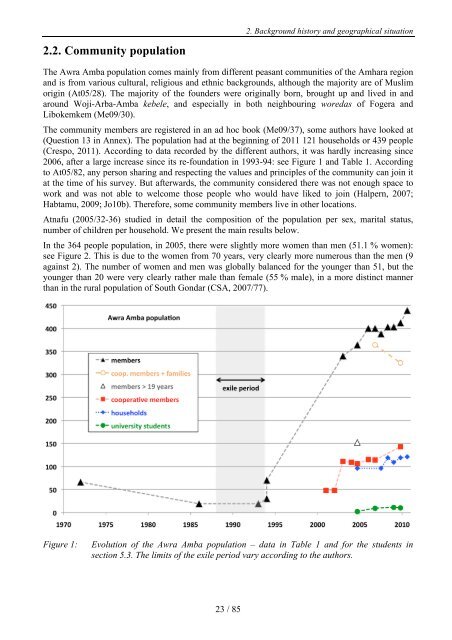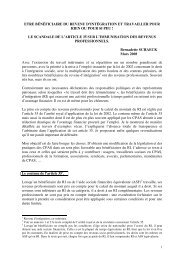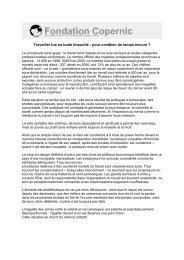Awra Amba RJ 300612 EN - Contacter un comité local d'Attac
Awra Amba RJ 300612 EN - Contacter un comité local d'Attac
Awra Amba RJ 300612 EN - Contacter un comité local d'Attac
You also want an ePaper? Increase the reach of your titles
YUMPU automatically turns print PDFs into web optimized ePapers that Google loves.
2. Backgro<strong>un</strong>d history and geographical situation<br />
2.2. Comm<strong>un</strong>ity population<br />
The <strong>Awra</strong> <strong>Amba</strong> population comes mainly from different peasant comm<strong>un</strong>ities of the Amhara region<br />
and is from various cultural, religious and ethnic backgro<strong>un</strong>ds, although the majority are of Muslim<br />
origin (At05/28). The majority of the fo<strong>un</strong>ders were originally born, brought up and lived in and<br />
aro<strong>un</strong>d Woji-Arba-<strong>Amba</strong> kebele, and especially in both neighbouring woredas of Fogera and<br />
Libokemkem (Me09/30).<br />
The comm<strong>un</strong>ity members are registered in an ad hoc book (Me09/37), some authors have looked at<br />
(Question 13 in Annex). The population had at the beginning of 2011 121 households or 439 people<br />
(Crespo, 2011). According to data recorded by the different authors, it was hardly increasing since<br />
2006, after a large increase since its re-fo<strong>un</strong>dation in 1993-94: see Figure 1 and Table 1. According<br />
to At05/82, any person sharing and respecting the values and principles of the comm<strong>un</strong>ity can join it<br />
at the time of his survey. But afterwards, the comm<strong>un</strong>ity considered there was not enough space to<br />
work and was not able to welcome those people who would have liked to join (Halpern, 2007;<br />
Habtamu, 2009; Jo10b). Therefore, some comm<strong>un</strong>ity members live in other locations.<br />
Atnafu (2005/32-36) studied in detail the composition of the population per sex, marital status,<br />
number of children per household. We present the main results below.<br />
In the 364 people population, in 2005, there were slightly more women than men (51.1 % women):<br />
see Figure 2. This is due to the women from 70 years, very clearly more numerous than the men (9<br />
against 2). The number of women and men was globally balanced for the yo<strong>un</strong>ger than 51, but the<br />
yo<strong>un</strong>ger than 20 were very clearly rather male than female (55 % male), in a more distinct manner<br />
than in the rural population of South Gondar (CSA, 2007/77).<br />
Figure 1:<br />
Evolution of the <strong>Awra</strong> <strong>Amba</strong> population – data in Table 1 and for the students in<br />
section 5.3. The limits of the exile period vary according to the authors.<br />
23 / 85

















